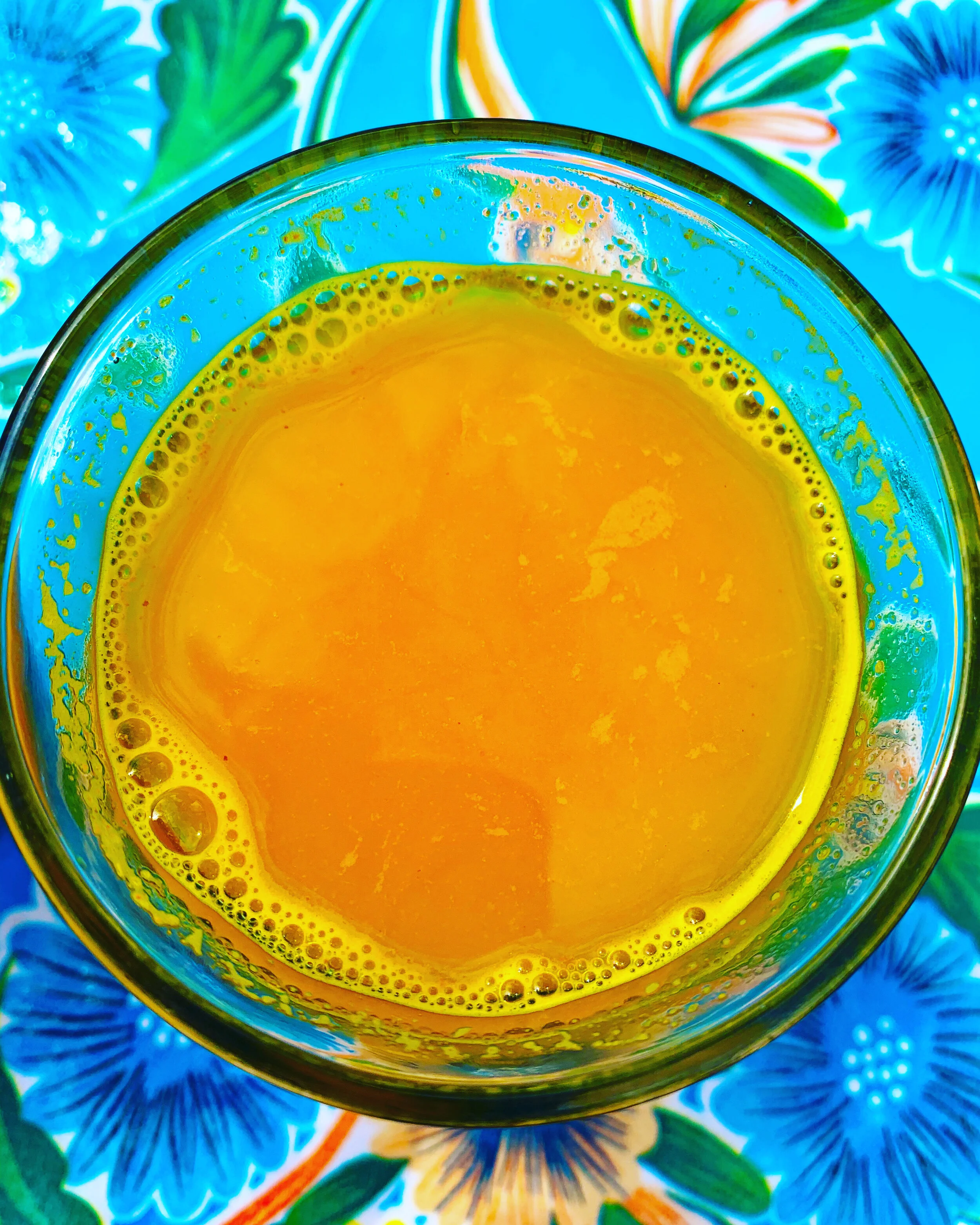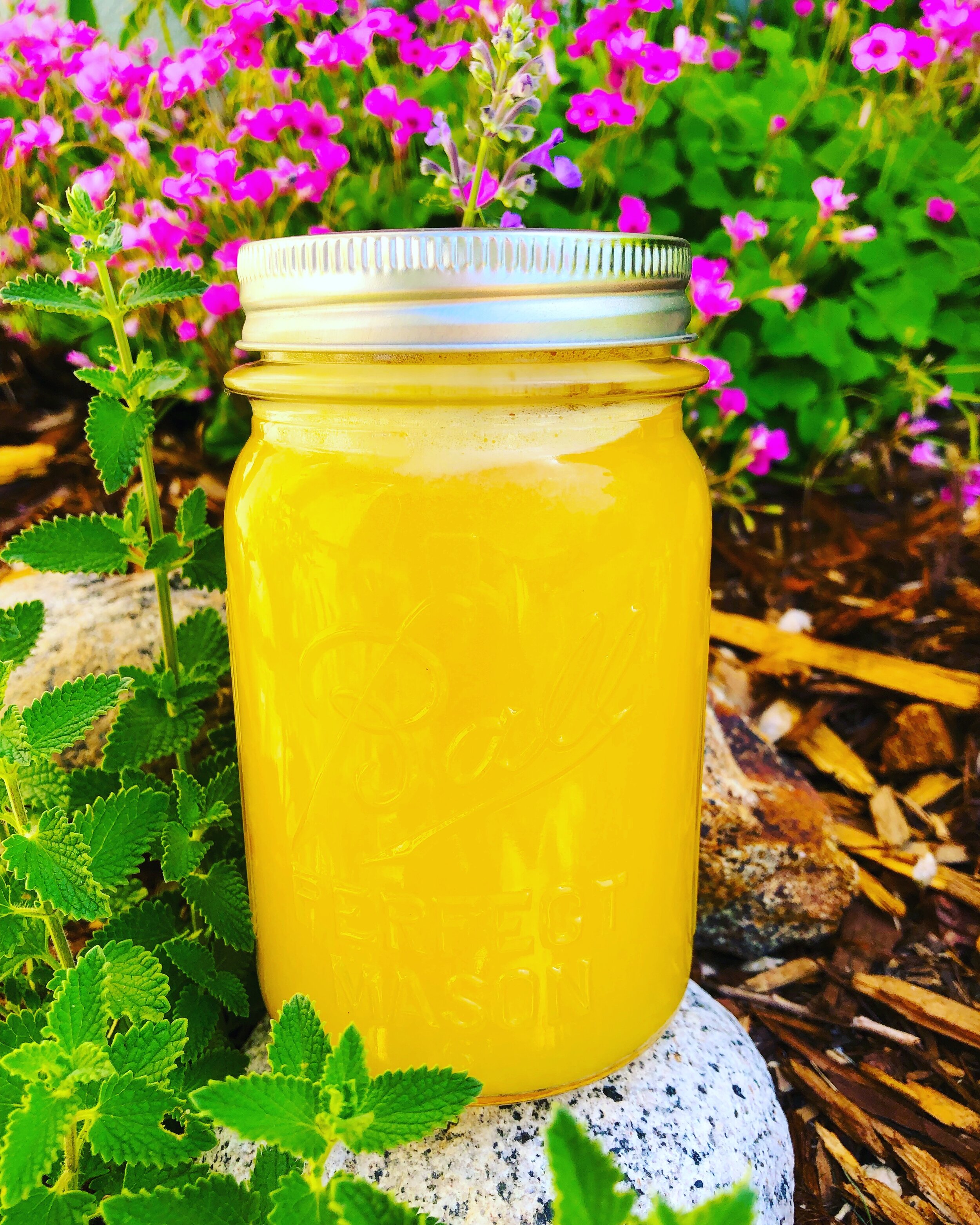Try this Indonesian Medicinal Tonic to Beat Inflammation... Jamu Juice to the Rescue!

Get ready to dive in and get science geeky!
In these uncertain and downright crazy times, we are all looking for ways bolster our health. I am here to tell you about a glowing golden orange elixir that is easy to make, delicious to sip on, and may be just what you need. It is having a moment right now, but it is ancient and powerful. It is called Jamu!
Jamu (or Djamu) is a traditional Indonesian medicinal tonic that has been brewed for at least 1200 years. The word Jamu is derived from the Javanese word, jampi which translates to "healing" and that it is!
Many versions of jamu have been handed down for generations, which reminds me of my grandmother’s traditional Jewish family recipes, none of which were written down. Rather, this cultural knowledge was passed on to us at the kitchen table from the time we were kids.
Jamu might be consumed as a tonic, to maintain health, but this liquid gold is also used in Indonesia to treat specific health issues, including high cholesterol, hypertension, allergies, and parasitic infections. Traditional jamu consists of a bewilderingly diverse mixture of herbs, roots, leaves, flowers, fruits, and bark and sometimes animal products as well, such as honey, milk, and eggs. Over 5,000 species of medicinal plants were retrieved from the Medicinal Herb Index in Indonesia for potential use in jamu preparations, depending on the ailment. Certainly jamu is a vital element of Indonesian traditional medicine. According to one study, 4.5% of Indonesians use herbal medicine daily with 17.4% using homemade herbal preparations. Some traditional jamu ingredients are extremely powerful and can be toxic if consumed regularly. Still, Indonesian healers regard jamu as an important part of their traditional medicine pharmacopeia.

Let’s chat about an excellent version of jamu you can make yourself. This anti-inflammatory tonic includes ginger and turmeric, two ingredients that are commonly found in traditional jamu and your local grocery store.
Ginger (Zingiber officinale) and turmeric (Curcuma longa) are two culinary herbs in the ginger family (Zingiberaceae) that are often used to infuse flavor in various foods. These days they are a routine part of many health-conscious consumers’ diet. However, they are also used as traditional medicines and are found in supplements in a more concentrated form. Both herbs can benefit overall health and have been found in studies to possess anti-inflammatory, antioxidant, antimicrobial, anti-cancer, anti-diabetic, and antiemetic (preventing vomiting) properties. They both contain neuroprotective compounds that may support memory and inhibit some forms of neuroinflammation.
Ginger with its delicious spicy flavor has been used to support digestive health and may be beneficial in calming diseases like inflammatory bowel disease (IBD). Ginger is famously used to treat nausea and vomiting. It is also used in treating gastrointestinal motility disorders. One major active component of ginger is a family of phenols called gingerols. These inhibit inflammation and pain, and have been shown to assist in blood sugar regulation and cardiovascular health. Rat studies have revealed that ginger boasts antioxidant properties equal to that of ascorbic acid (vitamin C) and has been found to be effective in reducing hepatitis C virus loads. Ginger extracts have been shown to inhibit a variety of bacteria, fungi, and viruses. Ginger may even have protective effects against respiratory disorders, which is on everyone’s radar right now with COVID-19.

Turmeric (Curcuma longa) has been the “golden pixy dust” spice in the past few years but also has a long history of medicinal use. One of its constituents, curcumin, is a polyphenol with a variety of health benefits attributed to its ability to act as a potent antioxidant and anti-inflammatory. Turmeric has been used in the management of a variety of inflammatory conditions, including arthritis, cardiovascular disease, metabolic syndrome, obesity-related inflammation, and neurodegenerative diseases like dementia. It’s mechanism of action has been shown to be its modulatory effect on inflammatory cytokines, which are the hallmark of inflammation.

Both ginger and turmeric have abundant research supporting their healing properties. So much research, in fact, that I could write a book on each. I have only shared a small piece of love on both—but please investigate their benefits on your own. The good news is, in general they are both safe to consume, as we commonly do in food.
Now, here is where we come to the yummy stuff. I love jamu’s spicy, robust flavor and its beautiful vibrant orange color. I drink it for its antioxidant and health promoting qualities, but I enjoy it for purely aesthetic reasons too. I keep it simple and use ingredients that I know are safe in moderate amounts. As a bonus, it is easy to whip up and will keep in the fridge for a few weeks! You can serve jamu as a therapeutic shot, or dilute and serve cold with bubbly water. Alternatively, you can add it to hot water and drink as a soothing tea. And the fun part is you can add extra ingredients to personalize the flavor. I made it today with both lime and freshly squeezed orange juice. Delish!
It is better if you use fresh turmeric as it tastes more potent, earthy and medicinal, but dried turmeric will work as well.
Give it a try and let me know what you think. Jamu=Heal! XO
Recipe Time
There are many variations on the recipe, so feel free to improvise on these possible ingredients:
-
freshly squeezed orange juice
-
black pepper (which increases availability of turmeric)
-
a splash of olive oil (which increases availability of turmeric)
-
tamarind paste
-
rooibos tea base
If you are using dried turmeric, use 1 heaping tablespoon.
(This recipe is from hormonesbalance.com)
Ingredients
*1/2 cup sliced fresh turmeric or 1 heaping tablespoon dried
*1/2 cup fresh ginger sliced
*4 cups filtered water
*2 tablespoons (or more to taste) fresh lime juice
*1-3 teaspoons honey

Instructions
-
Combine the ginger and turmeric in a blender along with the water. Puree until smooth.
-
Add turmeric-ginger mixture to a pot and bring to a simmer.
-
Turn down the heat as low as possible and let simmer for 25 minutes.
-
Remove the mixture from the heat and let cool for about 10 minutes before straining it into a jar. Stir in the lime juice and the honey. Add more honey if you prefer things on the sweeter side. Let the mixture cool completely before storing in the refrigerator.
-
To drink as a shot, just add 2-3 tablespoons to a glass and enjoy. To make a spritzer, add 2-3 tablespoons to a large glass along with a few orange slices and ice. Top with carbonated mineral water.
- Enjoy!
The Author:

Jan Goldberg, M.Sc., CN, M.Ed., FMCHC, NBC-HWC is a functional nutritionist and National Board Certified Health Coach who partners with women in the menopausal season of life and those living with chronic health challenges as they navigate their wellness journey. Her strengths-based approach is integrative, creative, and personalized. She focuses on a delicious food and healthy lifestyle approach to restore optimal health and vibrancy. You can connect with her at www.positivenutritionmbs.com
Additional Reading and Sources
Bodagh M., N., Maleki I., & Hekmatdoost A. (2019). Ginger in gastrointestinal disorders: A systematic review. (2019). Food Science and Nutrition, 7(1):96-108. doi: 10.1002/fsn3.807
Elfahmi, Herman J., Woerdenbag, Kayser O. (2014). Jamu: Indonesian traditional herbal medicine towards rational phytopharmacological use. Journal of Herbal Medicine, 4(2014): 51-73
Funk J., L., Frye J., B., Oyarzo J., N., Chen J., Zhang H., & Timmermann B., N. (2016). Anti-inflammatory effects of essential oils of ginger (Zingiber officinalis Roscoe) in experimental rheumatoid arthritis. PharmaNutrition, 4(3): 123-131. doi: 10.1016/j.phanu.2016.02.004
Hewlings S,. J., & Kalman D., S. (2017). Curcumin: A review of its effects on human health. Foods, 6(10): 92. doi: 10.3390/foods6100092
Mao Q., Q., Xu X., Y., Cao S., Y., Gan R., Y., Corke H., Beta T., & Li H., B. (2019). Bioactive compounds and bioactivities of ginger (Zingiber officinale Roscoe). Foods, 8(6): 185. doi: 10.3390/foods8060185
Mashhadi N., S., Askari G., Hariri M., Darvishi L., & Mofid M., R. (2013). Anti-oxidative and anti-inflammatory effects of ginger in health and physical activity: Review of current evidence, International Journal of Preventive Medicine, 4(Suppl 1): S36-S42.
Sulistoywati E., Hsu J. H., Cheng Y. B, Chang F. R., Chen Y., F., & Yeh J., L. (2017). Indonesian herbal medicine prevents hypertension-induced left ventricle hypertrophy by diminishing NADPH oxidase-dependent oxidative stress. Oncotarget, 8(49): 86784-86789. doi: 10.18632/oncotarget.21424
Suswardany, D., L, Sibbritt, D. W., Supardi, S., Pardosi, J., F., Chang, S., & Adams, J. (2017). A cross-sectional analysis of traditional medicine for malaria alongside free antimalarial drugs treatment amongst adults in high-risk malaria endemic provinces of Indonesia. PLos ONE 22, doi: 10.1371/journal.pone.0173522
Widoyowati, R., & Agil, M. (2017). Chemical constituents and bioactives of several Indonesian plants typically used in Jamu. Chemical and Pharmaceutical Bulletin, 66(5): 506-518 DOI: 10.1248/cpb.c17-00983


